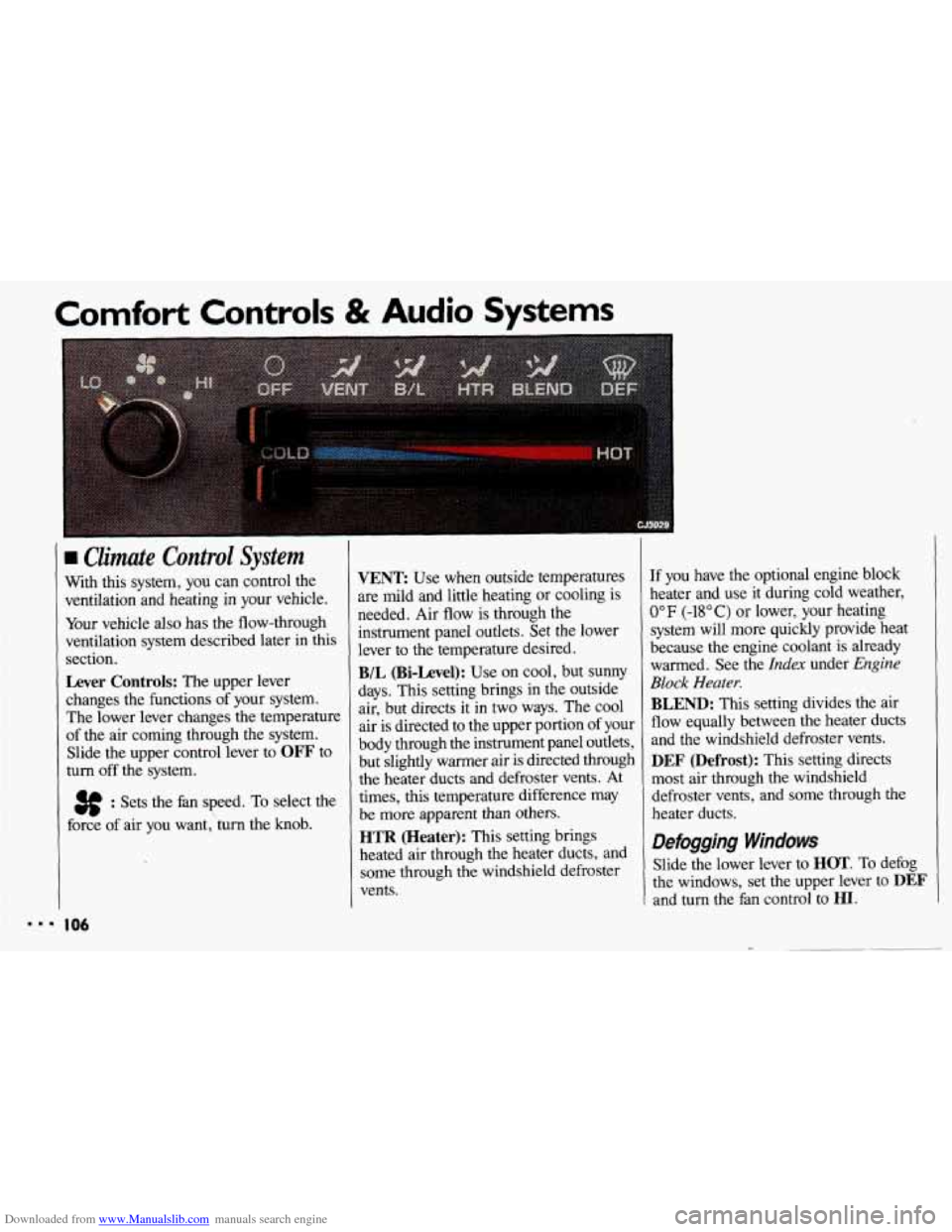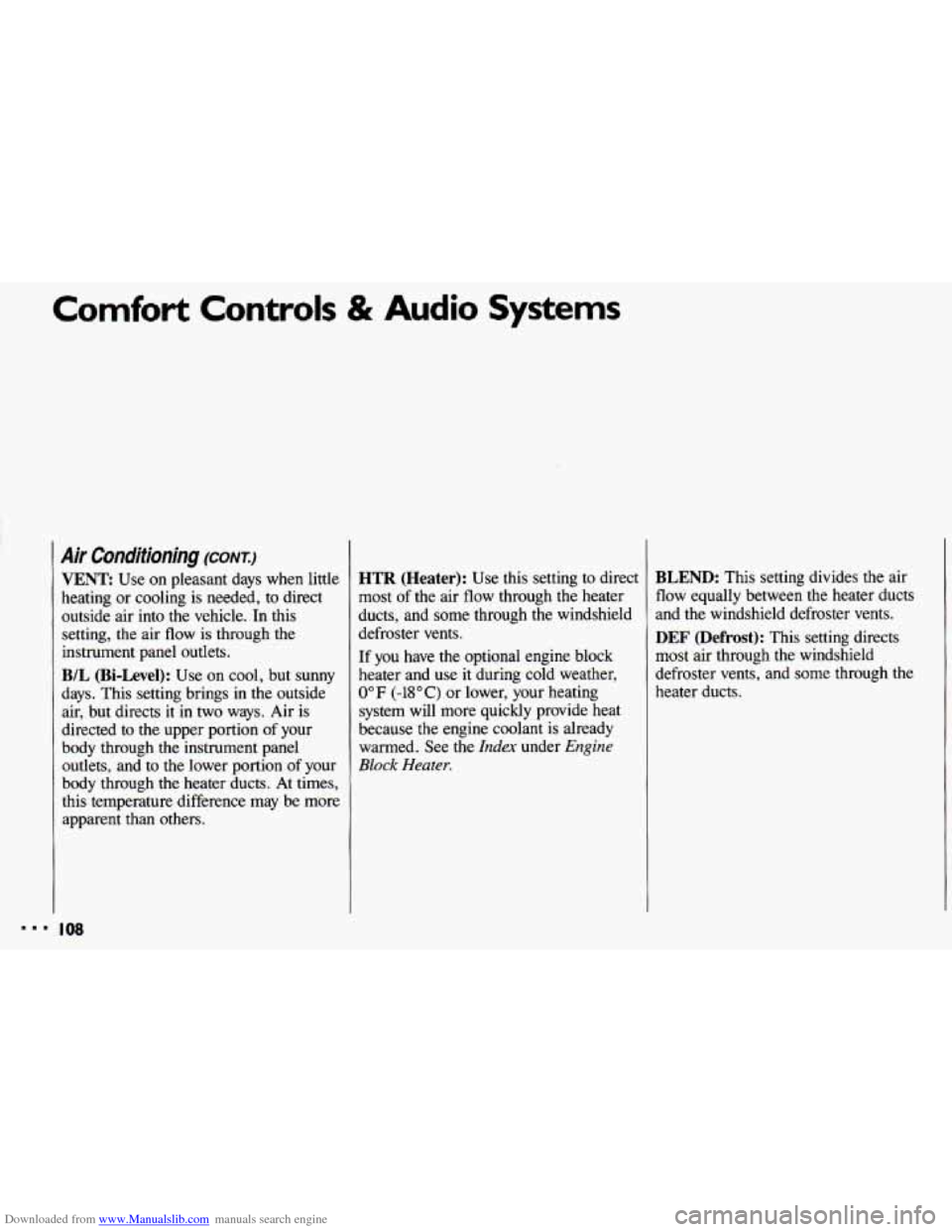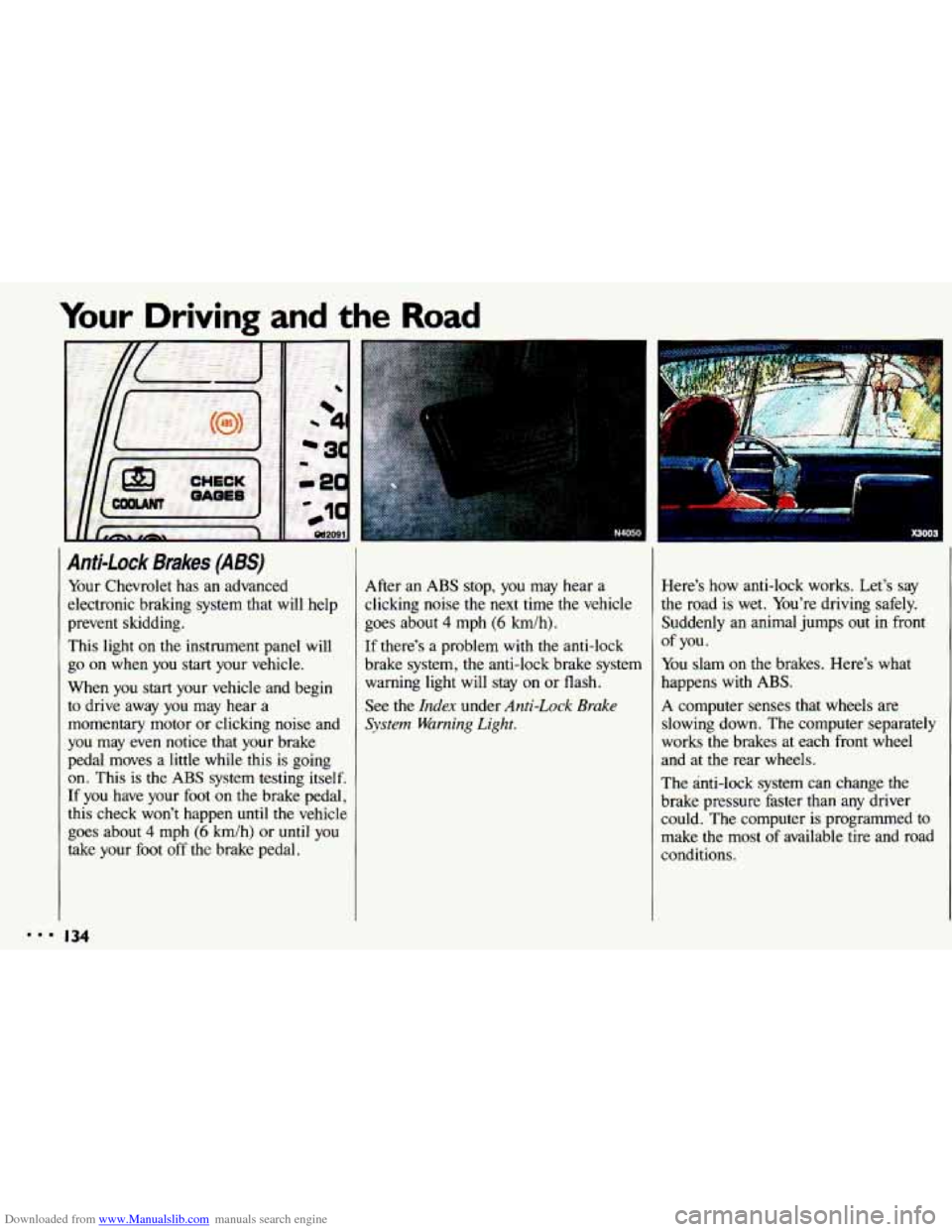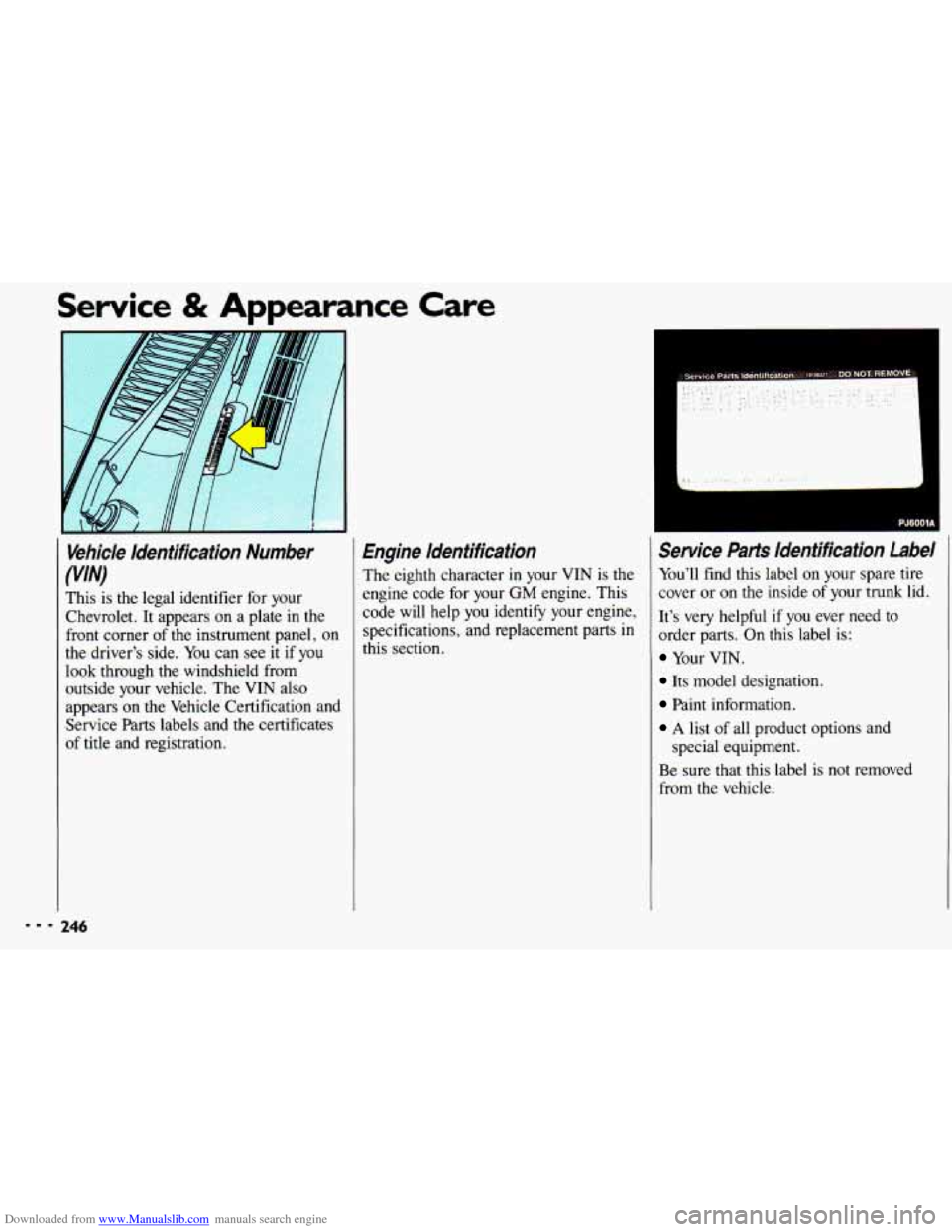Page 96 of 308
Downloaded from www.Manualslib.com manuals search engine Features & Controls
STANDARD CLUSTER
Instrument Panel Clusters
Your Chevrolet is equipped with one of
these instrument panel clusters, which
include indicator warning lights and
gages that are explained on the
following pages. Be sure to read about
those that apply to the instrument panel
cluster for your vehicle.
Speedometer and Odometer
Your speedometer lets you see your
speed in both miles per hour (mph) and
kilometers per hour (km/h). Your
odometer shows how far your vehicle
has been driven, in either miles (used in
the
U.S.) or kilometers (used in
Canada).
Tamper Resistant Odometer
Your Chevrolet has a tamper resistant
odometer. If
you see silver lines
between the numbers, you’ll
know that
someone has probably tried to
turn it
back,
so the numbers may not be true.
You may wonder what happens if your
vehicle needs a new odometer installed.
=.* 94
Page 108 of 308

Downloaded from www.Manualslib.com manuals search engine Comfort Controls & Audio Systems
Climate Control System
With this system, you can control the
ventilation and heating in your vehicle.
Your vehicle
also has the flow-through
ventilation system described later in this
section.
Lever Controls: The upper lever
changes the functions of your system.
The lower lever changes the temperature
of the air coming through the system.
Slide the upper control lever to
OFF to
turn
off the system.
3f : Sets the fan speed. To select the
force of air you want,'turn the knob.
I06
VENT Use when outside temperatures
are mild and little heating or cooling is
needed. Air flow is through the
instrument panel outlets. Set the lower
lever to the temperature desired.
B/L (Bi-Level): Use on cool, but SUMY
days. This setting brings in the outside
air, but directs it in
two ways. The cool
air is directed to the upper portion of your
body through the instrument panel outlets,
but slightly warmer air is directed through
the heater ducts and defroster vents. At
times, this temperature difference may
be more apparent than others.
HTR (Heater): This setting brings
heated air through the heater ducts, and
some through the windshield defroster
vents.
If you have the optional engine block
heater and use it during cold weather,
0°F (-18°C) or lower, your heating
system will more quickly provide heat
because the engine coolant is already
warmed. See the
Index under Engine
Block Heater.
BLEND: This setting divides the air
flow equally between the heater ducts
and the windshield defroster vents.
DEF (Defrost): This setting directs
most air through the windshield
defroster vents, and some through the
heater ducts.
Defogging Windows
Slide the lower lever to HOT. To defog
the windows, set the upper lever to
DEF
and turn the fan control to HI.
Page 110 of 308

Downloaded from www.Manualslib.com manuals search engine Comfort Controls & Audio Systems
Air Conditioning (CONX:)
VENT Use on pleasant days when little
heating or cooling is needed,
to direct
outside air into the vehicle.
In this
setting, the air flow
is through the
instrument panel outlets.
B/L (Bi-Level): Use on cool, but sunny
days. This setting brings in the outside
air, but directs it in two ways. Air is
directed to the upper portion
of your
body through the instrument panel
outlets, and to the lower portion of your
body through the heater ducts. At times,
this temperature difference may be more
apparent than others.
HTR (Heater): Use this setting to direct
most of the air flow through the heater
ducts, and some through the windshield
defroster vents.
If
you have the optional engine block
heater and use
it during cold weather,
0°F (-18°C) or lower, your heating
system will more quickly provide
heat
because the engine coolant is already
warmed. See the
Index under Engine
Block Heater.
BLEND: This setting divides the air
flow equally between the heater ducts
and the windshield defroster vents.
DEF (Defrost): This setting directs
most air through the windshield
defroster vents, and some through the
heater ducts.
Page 136 of 308

Downloaded from www.Manualslib.com manuals search engine Your Driving and the Road
Anti-Lock Brakes (ABS)
Your Chevrolet has an advanced
electronic braking system that will help
prevent skidding.
This light
on the instrument panel will
go
on when you start your vehicle.
When you start your vehicle and begin
to drive away you may hear a
momentary motor or clicking noise and
you may even notice that your brake
pedal moves a little while this is going
on. This is the ABS system testing itself.
If you have your foot on the brake pedal,
this check won’t happen
until the vehicle
goes about
4 mph (6 km/h) or until you
take your foot
off the brake pedal. After an
ABS stop,
you may hear a
clicking noise the next time the vehicle
goes about
4 mph (6 km/h).
If there’s a problem
with the anti-lock
brake system, the anti-lock brake system warning light will stay on or flash.
See
the Index under Anti-Lock Brake
System Warning Light.
Here’s how anti-lock works. Let’s say
the road is wet. You’re driving safely.
Suddenly an animal jumps out
in front
You slam
on the brakes. Here’s what
happens with ABS.
A computer senses that wheels are
slowing down. The computer separately
works the brakes at each front wheel
and at the rear wheels.
The anti-lock
system can change the
brake pressure faster than any driver
could. The computer is programmed to
make the most of available tire and road
conditions.
of you.
134
Page 176 of 308

Downloaded from www.Manualslib.com manuals search engine Problems on the Road
7
Engine Overheating
You will find a coolant temperature gage
on your Chevrclet's instrument panel.
If your engine catches fire because
you keep driving with
no coolant,
your vehicle can be badly
:z
damaged. The costly repairs wouf~,~
not be covered by your warranty.
<* .>* i
If Steam is Corning from Your Engine
A
Steam from an overheated
engine can burn
you badly,
even if you just open the hood. Stay
away from the engine
if you see or
hear steam coming from it. Just
turn it off and get everyone away
from the vehicle until it cools down.
Wait until there is no sign
of steam
or coolant before opening the hood.
If
you keep driving when your
engine is overheated, the liquids in
it can catch fire. You or others
could be badly burned. Stop your
engine if it overheats, and get out
of the vehicle until the engine is
cool.
If No Stem is Coming from Your
Engine:
If you get the overheat warning but see
or hear no steam, the problem may not
be too serious. Sometimes
the engine
can get a little too hot when you:
Climb a long hill on a hot day.
Stop after high speed driving.
Idle for long periods in traffic.
== 174
Page 242 of 308
Downloaded from www.Manualslib.com manuals search engine Service & Appearance Care
Cleaning Vinyl
Just use warm water and a clean cloth.
Rub with a clean, damp cloth to
remove dirt.
You may have to do it
more than once.
polish will stain if you don’t get them
off quickly. Use a clean cloth and
solvent-type vinyl/leather cleaner.
Things like tar, asphalt and shoe
Cleaning the Top of the
instrument Panel
Use only mild soap and water to clean
the top surfaces of the instrument panel.
Sprays containing silicones or waxes
may cause annoying reflections
in the
windshield and even make it difficult to
see through the windshield under certain
conditions.
Care of Safety Belts
Keep belts clean and dry.
CAUTION
Do not bleach or dye s&ty
severely weaken them. h a crash
they might not be able to provide
adequate protection. Clean safety
belts only with mild soap and
lukewarm water.
- belts. If you do, it may
. . 240
Page 248 of 308

Downloaded from www.Manualslib.com manuals search engine Service & Appearance Care
WIN)
Vehicle ldentification Number
This is the legal identifier for your
Chevrolet. It appears on a plate in the
front corner
of the instrument panel, on
the driver’s side. You can see it
if you
look through the windshield from
outside your vehicle. The VIN also
appears
on the Vehicle Certification and
Service Parts labels and the certificates
of title and registration.
Engine ldentification
The eighth character in your VIN is the
engine code for your
GM engine. This
code will help
you identify your engine,
specifications, and replacement parts
in
this section.
Service Parts Identification Label
You’ll find this label on your spare tire
cover or on the inside
of your trunk lid.
It’s very helpfbl
if you ever need to
order parts. On this label is:
Your VIN.
Its model designation.
Paint information.
A list of all product options and
special equipment.
Be sure that this label is not removed
from the vehicle.
Page 249 of 308
Downloaded from www.Manualslib.com manuals search engine Add-on Electrica i Equipment
Don’t add anything electrical to
your Chevrolet unless you check
with your dealer first. Some
electrical equipment can damage your vehicle and the damage
wouldn’t be covered by your
warranty. Some
of it can just ke-
other things, from - .. working as tt,
should.
..
1 Fuses & Circuit Breakers
The wiring circuits in your vehicle are
protected from short circuits by a
combination
of fuses, circuit breakers.
and fusible thermal links
in the wiring
itself. This greatly reduces the chance of
fires caused by electrical problems.
The fuse panel is located under the
lower left side of the instrument panel.
To identih and check fuses, refer to the
Fuse Usage chart.
X5027
Look at the silver-colored band inside
the fuse. If the band is broken or
melted, replace the fuse. Be sure you
replace a bad fuse with a new one
of the
identical size and rating.